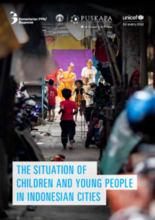The number of children in urban areas in Indonesia has continued to increase. Despite the fact that children in urban areas fare better on several measures of wellbeing compared to those in rural areas, marginalized groups still fail to survive and thrive. Access to services and opportunities for a better quality of life in cities are limited for the urban poor and vulnerable, of which children and young people account for almost a third. This study explores children’s and young people’s characteristics, well-being, and lived experiences, providing a critical foundation for policy and programming to turn the myth of urban opportunity into a reality for all children and young people, particularly those who are marginalized.
This study combines a quantitative overview of the leading indicators of well-being among children and young people in cities, with a qualitative, in-depth understanding of how daily life is perceived and experienced by the urban young. The quantitative analysis has predominantly employed existing national data sets, such as The National Socioeconomic Survey (SUSENAS) and the Indonesia Demographic and Health Survey (IDHS), to understand the situation of children in urban settings. The secondary analysis assessed approximately 20 indicators that are based on the SDG/Sustainable Development Goal themes, and that align with the Indonesian National Medium Term Development Plan 2020–2024. The combination of secondary analysis, a systematic literature review, and consultations with children and young people generated insights on the constraints and opportunities faced by them and their broader urban communities.
Key Findings
Although some vulnerabilities are shared by urban and rural children and young people, they may manifest differently. Findings from this study demonstrate that challenges for them often present opportunities; the two are not mutually exclusive. The gap between urban and rural outcomes might be partially explained by differing official definitions and classifications of urban and rural areas. The main findings around the challenges and opportunities faced by children living in urban areas are presented by age group, gender, urban/rural comparison, and socioeconomic background, when possible.

